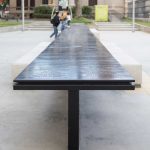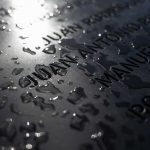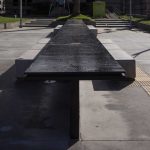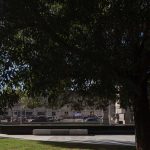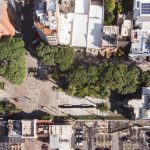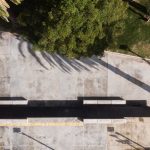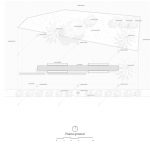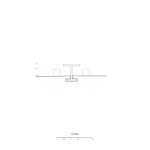Memorial ex penal Puntas Carretas (Montevideo, Uruguay) por TATU Arquitectura + Federico Lapeyre + Federico Lagomarsino + Lourdes Silva. A lo largo de la historia de la humanidad, la mesa ha jugado un rol fundamental en muchos aspectos, adquiriendo un gran valor cultural y siendo escenario de infinitos usos y actividades. Muchos de los grandes acontecimientos han sido y seguirán siendo registrados en torno a una mesa: Las instrucciones del año XIII fueron redactadas y firmadas sobre la mesa de la asamblea general constituyente; la democracia republicana se materializa en las mesas de votación, grandes historias de amores y amigos surgen en una mesa de bar; y la familia se reúne alrededor de la mesa los domingos para almorzar y compartir. La mesa con su genealogía histórica, no es ajena a los diferentes momentos que han dejado huellas importantes en la historia del hombre; reflexionar en torno a la potencia afectiva de dicho objeto, es construir espacios donde desplegar diferentes formas de habitar, ser y estar con los otros.
Concepto
Somos animales con memoria, por tanto, animales con la capacidad para contar historias. En este sentido, la mesa, ha funcionado a lo largo del tiempo como un dispositivo de narración, de anécdotas… que hacen de ella un campo comunicacional potente, donde puede coexistir lo público y lo privado, lo domestico y lo territorial. En un acto de comunicación y tensión urbana, el proyecto se concibe a partir de un gesto sutil y concentrado, pero potente a la hora de integrar y activar espacio público. Un artificio, que invita al uso. Una mesa como objeto apropiable, como el mínimo gesto de arquitectura para una construcción colectiva. Una mesa como un dispositivo singular integrado al paisaje, que amplifica, unifica y cobra protagonismo desde el usufructo del espacio.
Simpleza Ad Hoc
Las premisas de proyecto parten de la simpleza constructiva. En tal sentido, la intervención apunta a una síntesis de muy pocos elementos confeccionados «a medida», que buscan lograr con el mínimo esfuerzo el mayor alcance. 4 placas metálicas conforman el tablero y el apoyo en forma de «T» generando una superficie extruida de 24 metros de largo, que se posiciona paralela a la calle Ellauri. El cuadrante de césped posterior se sustituye por un pavimento continuo de losetones de hormigón de alta resistencia, conformando los bancos y una explanada neutra, que multiplica el área de uso de la plaza. Un gesto que conecta ambos espacios continuos del entorno y logra dotar de protagonismo al objeto central, transformándolo en un verdadero atractor.
Ascetismo material
La materialidad, responde de forma directa a las condiciones de implantación y de mantenimiento del memorial. El gran tablero se concibe con placas de chapa de hierro pintadas de color negro abocando la solemnidad, en contraste con el hormigón de pavimentos y bancos, que se plantea como una alternativa de material noble y resistente al uso activo del espacio público.
Nota
Durante gran parte de la estadía, «los presos recibían la visita de sus familiares en el mismo recinto que el resto y con la misma modalidad, una mesa larga de madera. La única regla establecida era que la visita se sentara a un lado de aquella mesa y los presos del otro…».
Todo sistema de objetos construye su narrativa, su memoria, sus afectos, supone una construcción que pueda ser habitada. Propicia un conglomerado de usos, prácticas y subjetividades que tornan vital, lo aparentemente inerte: animamos lo inanimado; lo hacemos vivir, como una ceremonia espiritista y por qué no, en muchos casos, como una práctica política de acercamiento y encuentro.
La mesa y su genealogía histórica, para pensarla en el cruce entre lo diacrónico y lo sincronico, no escapa a una lógica de relaciones con lo humano, con los diferentes momentos sociales e históricos que la civilización ha trazado para contarse; reflexionar entorno a la potencia afectiva del mobiliario, es reflexionar sobre el modo en que los objetos se desbordan en su funcionalidad, construyendo espacios donde desplegar diferentes formas de habitar, ser y estar con los otros.
Somos animales con memoria, por tanto, animales con la capacidad para contar historias. En este sentido, la mesa, ha funcionado a lo largo del tiempo como un dispositivo de narración, construido por un fino montaje de gestos, anécdotas, conductas, deseos…que hacen de aquella, no solo el espacio donde puede coexistir y ser trasegado lo publico y lo privado, lo domestico con lo territorial, sino como un campo comunicacional fundante, donde enunciados y enunciatarios se mezclan en la verborragia del banquete, en el solipsismo de la conferencia, en el dialogo entre pares o en el encuentro deseoso por reconocer al otro como presente, cercano, vivo.
La mesa, esa porción de suelo elevado, ese territorio en disputa, escenario de sacrificios y de pactos, es mucho más que un objeto que soporta lo humano en sus claroscuros, es también, una maquina de significados, una morada para la disputa y el amor: un paisaje de miradas es hilado sobre ella. Su altura no es solo el levantamiento del piso, es también, el acercamiento al cielo, la generación de un entre, de un espacio intersticial donde lo genealógico, lo terrestre y lo cósmico sean conjugados en un objeto o quizá en lo que devino un espacio por la usologia de los humanos.
La mesa es un espacio para el lugar, esta relación de contenido y continente, esta condición de lo «albergado», es de relevancia si entendemos al espacio como una construccción trialéctica: lo practicamos, lo representamos y lo percibimos.
La mesa, por tanto, es mucho más que su cualidad objetual, es un lugar donde nos prácticamos, nos representamos y nos percibimos,un sitio donde construirnos y deconstruirnos con los otros.
Ficha técnica
Nombre: Memorial ex penal Puntas Carretas
Ubicación: Punta Carretas, Montevideo, Uruguay
Oficina de Arquitectura: TATU Arquitectura + Federico Lapeyre + Federico Lagomarsino + Lourdes Silva
Arquitectos a cargo: Leandro Alegre, Horacio Goday, Martin Olivera, Federico Lapeyre, Federico Lagomarsino, Lourdes Silva
Superficie construida: 467 m2
Año finalización construcción: 2020
Fotos: Marcos Guiponi
Contacto
https://www.tatuarq.com
English version
Intro
Throughout the history of humanity, the table has played a fundamental role in many aspects, acquiring a great cultural value and being the stage of infinite uses and activities. Many of the great events have been and will continue to be recorded around a table: The instructions of the year XIII were drafted and signed on the table of the general constituent assembly; republican democracy materializes at the polling stations, great stories of love and friends arise at a bar table; and the family gathers around the table on Sundays for lunch and sharing. The table with its historical genealogy, is no stranger to the different moments that have left important traces in the history of man; to reflect on the affective power of this object is to build spaces where different ways of living, being and being with others can be displayed.
Concept
We are animals with memory, therefore, animals with the ability to tell stories. In this sense, the table has worked over time as a device of narration, of anecdotes… that make it a powerful communicational field, where the public and the private, the domestic and the territorial can coexist. In an act of communication and urban tension, the project is conceived from a subtle and concentrated gesture; but powerful when it comes to integrating and activating public space. An artifice, which invites use. A table as an appropriable object; as the minimum gesture of architecture for a collective construction. A table as a singular device integrated into the landscape, which amplifies, unifies and takes center stage from the usufruct of space.
Ad Hoc Simplicity
The premises of the project start from constructive simplicity. In this sense, the intervention aims at a synthesis of very few elements «custom made», which seek to achieve with the minimum effort the greatest scope. Four metal plates make up the board and the support in «T» shape, generating an extruded surface of 24 meters long, which is positioned parallel to Ellauri Street. The rear grass quadrant is replaced by a continuous pavement of high-strength concrete slabs, forming the benches and a neutral esplanade, which multiplies the area of use of the square. A gesture that connects both continuous spaces of the environment and manages to give prominence to the central object, transforming it into a true attractor.
Material Asceticism
Materiality responds directly to the conditions of implantation and maintenance of the memorial. The large board is conceived with iron sheet plates painted black addressing the solemnity, in contrast to the concrete of pavements and benches, which is proposed as an alternative noble material and resistant to the active use of public space.
Note
During much of the stay, «the prisoners received the visit of their relatives in the same enclosure as the rest and with the same modality, a long wooden table. The only rule established was that the visitor would sit on one side of that table and the prisoners on the other…».
Every system of objects constructs its narrative, its memory, its affections, supposes a construction that can be inhabited. It fosters a conglomeration of uses, practices and subjectivities that make the apparently inert vital: we animate the inanimate; we make it live, as a spiritualist ceremony and why not, in many cases, as a political practice of rapprochement and encounter. The table and its historical genealogy, to think about the intersection between the diachronic and the synchronous, does not escape a logic of relations with the human, with the different social and historical moments that civilization has traced to tell itself; to reflect on the affective power of furniture is to reflect on the way in which objects overflow in their functionality, building spaces where different ways of living, being and being with others can unfold.
We are animals with memory, therefore, animals with the ability to tell stories. In this sense, the table has worked over time as a storytelling device, built by a fine montage of gestures, anecdotes, behaviors, desires… that make it, not only the space where the public and the private, the domestic and the territorial, can coexist and be shuffled, but as a founding communicational field, where statements and enunciators are mixed in the verbiage of the banquet, in the solipsism of the conference, in the dialogue between peers or in the encounter eager to recognize the other as present, close, alive.
The table, that portion of raised ground, that disputed territory, the scene of sacrifices and pacts, is much more than an object that supports the human in its chiaroscuros, it is also a machine of meanings, a dwelling place for dispute and love: a landscape of looks is threaded on it. Its height is not only the lifting of the floor, it is also the approach to the sky, the generation of an in between, of an interstitial space where the genealogical, the terrestrial and the cosmic are conjugated in an object or perhaps in what became a space by the usology of humans.
The table is a space for the place, this relationship of content and continent, this condition of the «housed», is of relevance if we understand space as a trialectic construction: we practice it, we represent it and we perceive it.
The table, therefore, is much more than its objectual quality, it is a place where we practice, represent and perceive ourselves, a place to build and deconstruct ourselves with others.













